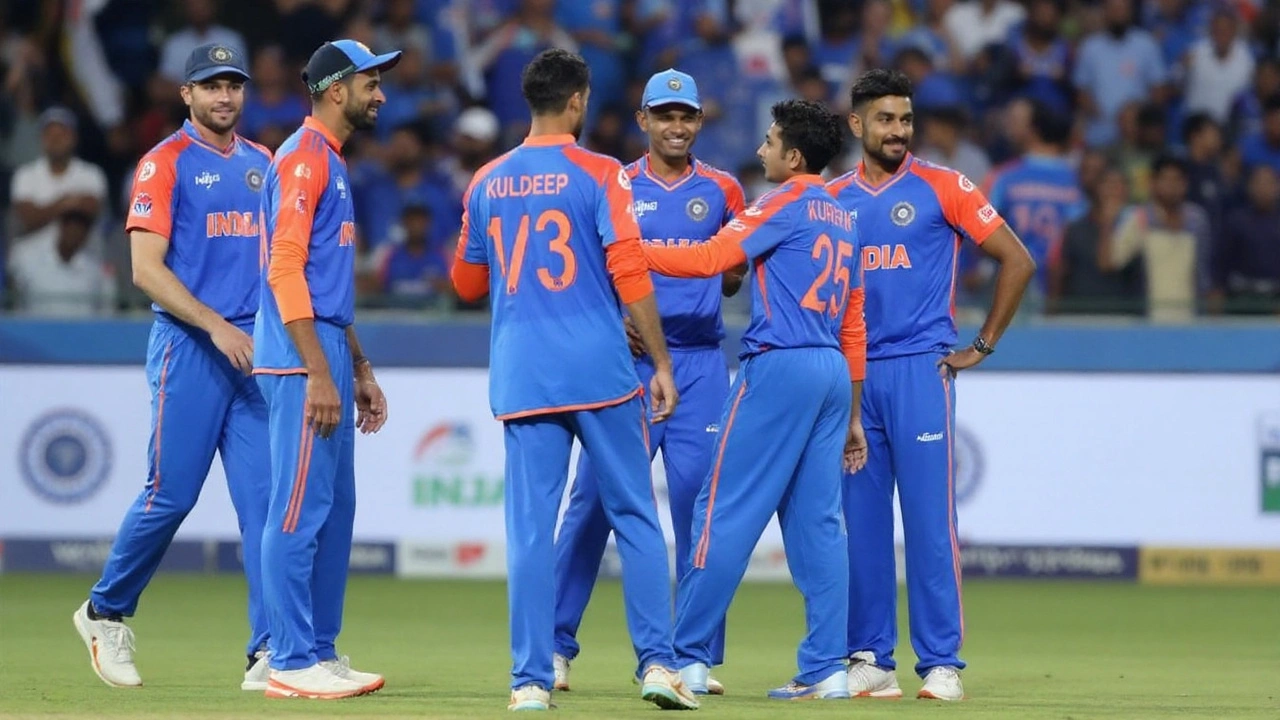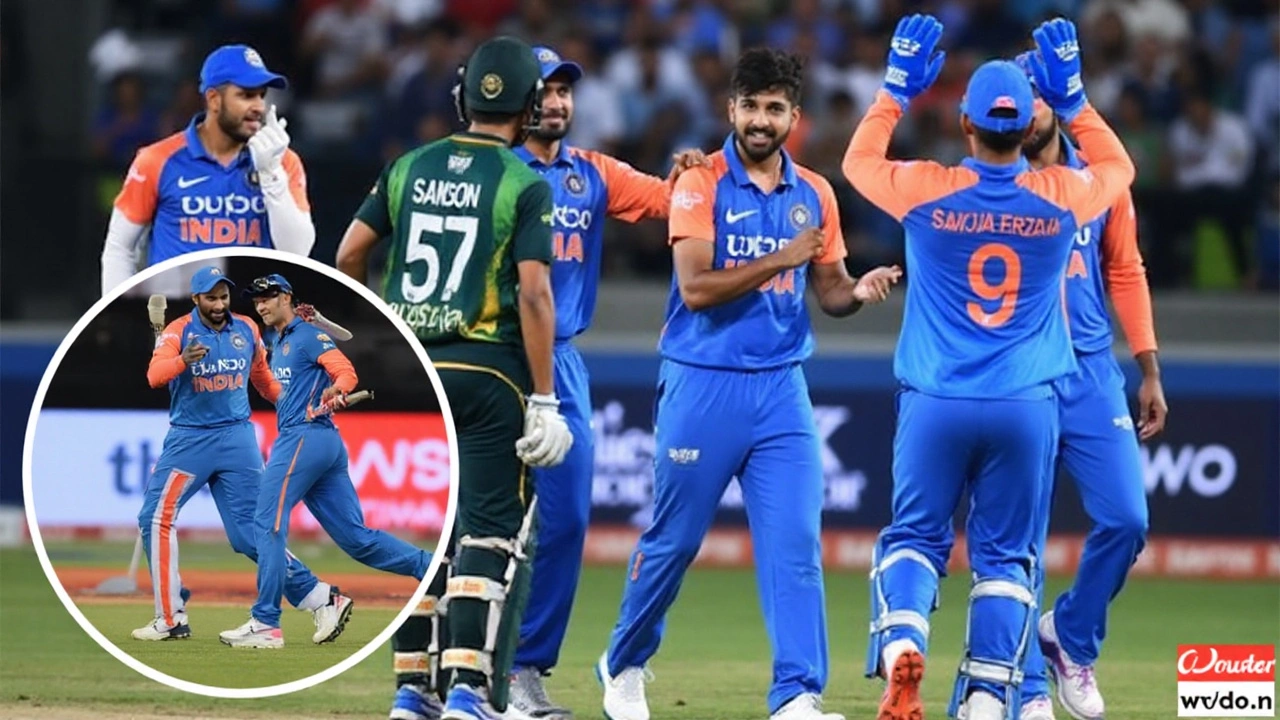India flatten Pakistan in Dubai, Kuldeep’s spell sets it up
India needed only 95 balls to end the most-watched rivalry in cricket. In a high-security, sold-out Dubai International Cricket Stadium, the defending bowlers set the tone, the batters finished the job, and the scoreboard read 131/3 in 15.5 overs. For Pakistan, a decision to bat first unraveled into 127/9, and the gulf only grew wider from there.
Pakistan’s plan was clear: post something above par and squeeze with the ball. But the surface had that familiar Dubai grip, and India’s spinners made it look two-paced. The visitors lost rhythm in the middle overs and never really recovered. Sahibzada Farhan fought for 40, Shaheen Shah Afridi swung late for an unbeaten 33, but the middle was a blur of dots, misreads, and quiet overs.
Kuldeep Yadav was the difference again. His 4 overs went for just 18 and brought three wickets, all at key moments. Pakistan’s batters played him from the crease and got punished when the ball dipped and straightened. When they tried to charge, the length was dragged back; when they waited, the googly snuck in. It was controlled, cold, and clinical—the kind of spell that kills a chase before it even exists.
India backed Kuldeep with discipline at both ends. The seamers took pace off, dragged lengths into the pitch, and made Pakistan earn every run. Boundaries dried up, singles weren’t easy, and panic set in after the powerplay. By the time Shaheen found his swing for those lusty blows at the death, the innings had already shrunk into damage limitation.
Chasing 128, India didn’t blink. Abhishek Sharma and Tilak Varma set the tempo with clean strokeplay and smart running. Both made 31, both looked in control, and both forced Pakistan to chase angles they didn’t like. Once the field spread, the gaps opened up. India’s approach was simple: take what’s on offer, don’t gift chances, and keep the rate under control.
At the other end, Suryakumar Yadav did what he does best—pick gaps from unusual angles and flip the field with late wrists. He finished unbeaten on 47, paced it without fuss, and never allowed the game to get messy. For Pakistan, Saim Ayub was the lone bright spot with the ball, picking all three wickets and briefly checking India’s charge. It wasn’t close enough to matter.
The story of the night wasn’t only about runs and wickets, though. It was about India’s clarity. The bowlers knew their plans in the middle overs. The batters knew the chase was more about patience than fireworks. And the fielding backed it up—clean ground work, sharp positioning, and no freebies.
India now sit on 4 points from two games after also beating UAE. Pakistan, who edged past Oman earlier, stay on 2. In a short-group tournament where a single result can tilt the table, this was a statement. One team looked settled; the other looked like it is still searching for the right blend against quality spin.
- Pakistan 127/9 in 20 overs: Farhan 40, Shaheen Afridi 33*; Kuldeep Yadav 3/18
- India 131/3 in 15.5 overs: Suryakumar Yadav 47*, Tilak Varma 31, Abhishek Sharma 31; Saim Ayub 3 wickets
- Result: India won by 7 wickets
- Group A: India 4 points (2 matches), Pakistan 2 points (2 matches)

What it means, why it worked, and what comes next
The stakes around this rivalry always feel oversized, but the cricket was refreshingly simple. Pakistan batted first on a surface that rewarded patience and craft. India read it faster. Once the ball began to grip, Kuldeep’s variations took over, and the middle overs—often where T20s drift—became the choke point.
For Pakistan, the pattern is familiar: solid intent at the top, a stall against wrist-spin, and a late scramble that looks good on highlights but doesn’t change the math. Farhan’s 40 gave them a base; they couldn’t keep it moving. Shaheen’s late blows were fun; they weren’t enough. The middle order needs a way to rotate against quality spin without waiting for the release ball. Until that happens, totals like 127 will keep showing up on sticky nights.
India, meanwhile, look balanced and sure of themselves. The captaincy from Suryakumar Yadav mirrors India’s batting: proactive, flexible, and unafraid to shift gears. He has match-up options, especially in the middle—wrist-spin, a change-up seam option, and catchers placed for miscues. On the batting side, there’s depth and clarity. No panic, no slog, just control.
Kuldeep Yadav’s form is an obvious lift. Two games, two Player of the Match awards, and the sense that opponents enter with a plan and leave with a headache. His lengths are tighter, his pace variation is sneaky, and there’s just enough drift to draw errors. On nights like this, he doesn’t just take wickets; he shapes the contest.
The Dubai pitch deserves a word, too. It wasn’t a minefield, but it punished hard hands and rewarded bowling into the surface. Pakistan will ask if batting second might have been smarter with a modest target likely. Even without heavy dew, chases here tend to simplify decisions—especially when the opposing spin attack is as settled as India’s.
Zoom out, and the rivalry angle writes itself. India have strung together a run of big-night wins against Pakistan in global events, and this one fits the trend. It wasn’t a last-over scrap or a collapse-and-rescue. It was orderly, almost unemotional—a sign of a team that trusts its processes more than the occasion.
For Pakistan, the fixes are clear even if they’re not easy. They need a middle order that handles high-quality spin with singles, not stasis. They need clearer roles between anchors and accelerators. And they might need a second specialist slow option if conditions keep offering grip. Saim Ayub’s three strikes were a boost, but he can’t do it alone in a chase defense unless there’s a total to protect.
For India, the takeaway is momentum and a settled blueprint. Suryakumar at the helm, Kuldeep dictating the middle, and a lineup where both Abhishek Sharma and Tilak Varma can cash in on powerplay and post-powerplay fields. It’s a clean template for tournament play.
There’s still time for twists. Group dynamics can flip with one off-night. But after this, India look on a smooth path toward the next phase, while Pakistan have work to do and not much time to do it. The energy in the stands told its own story—loud, tense, and then, very quickly, resigned as the chase glided home.
As the tournament rolls on, everyone else will be taking notes. Keep Kuldeep quiet or get swallowed in the middle. Keep Suryakumar off the sweep and scoop zones or watch angles turn into boundaries. And if the pitch grips, bring your best spin plan or accept you’re 20 short. That’s what the night in Dubai laid bare—simple cricket truths, executed with precision on a big stage at the Asia Cup 2025.
